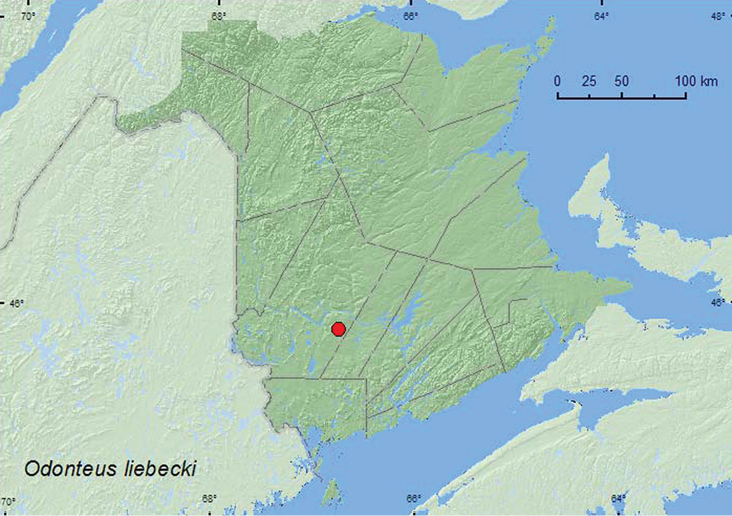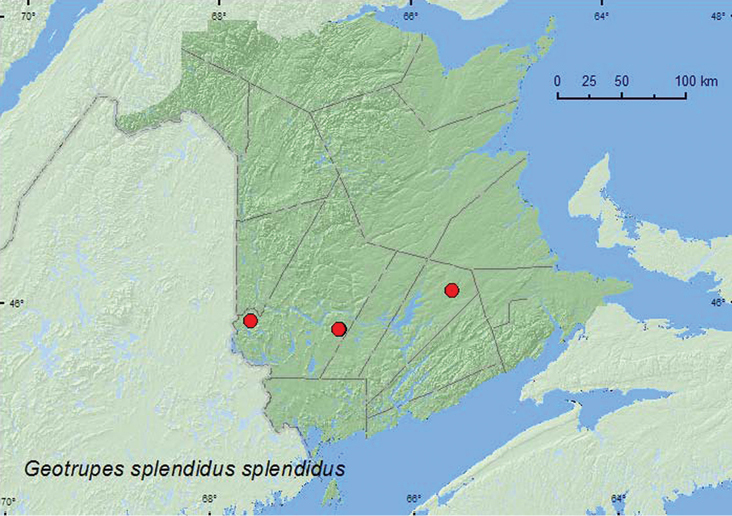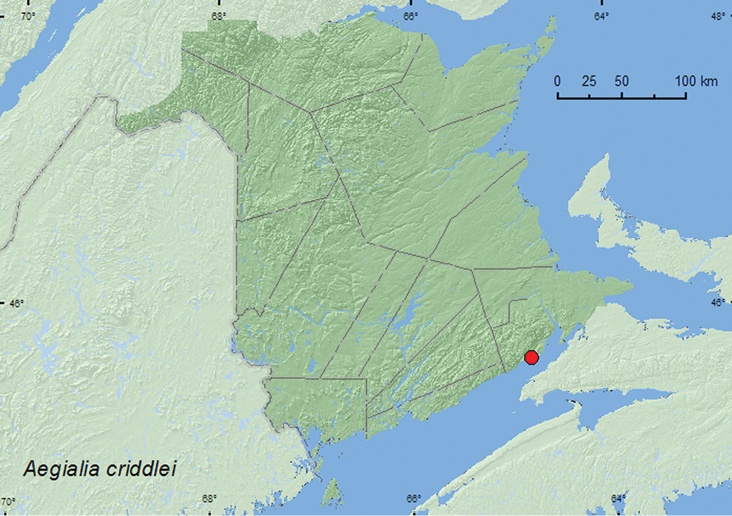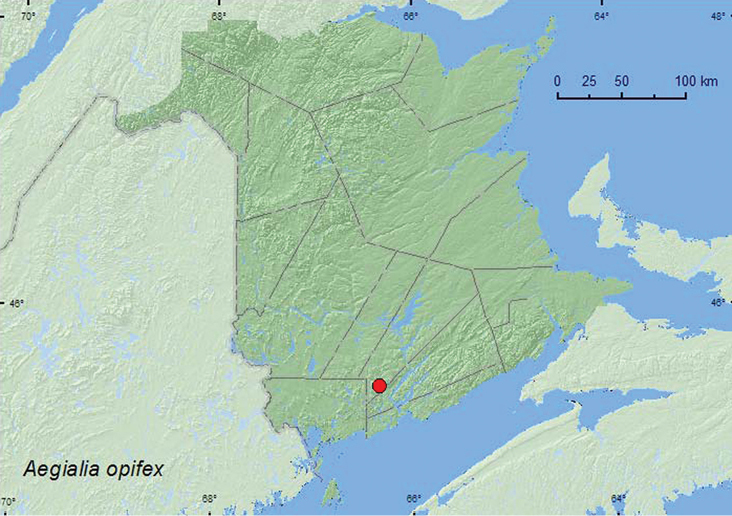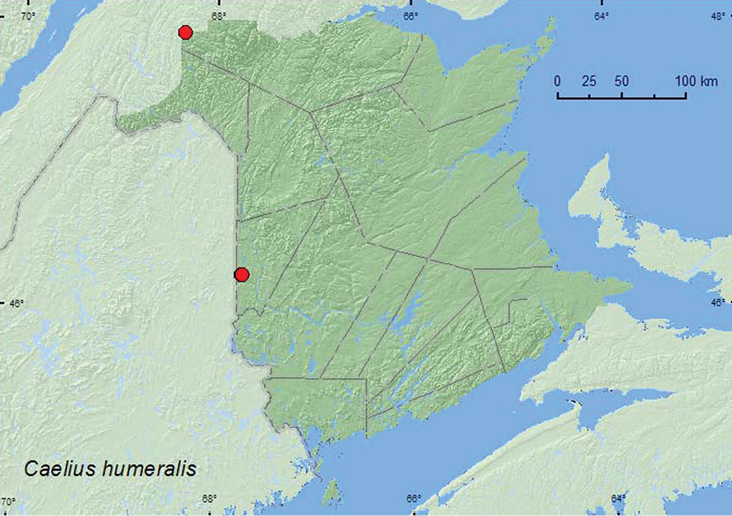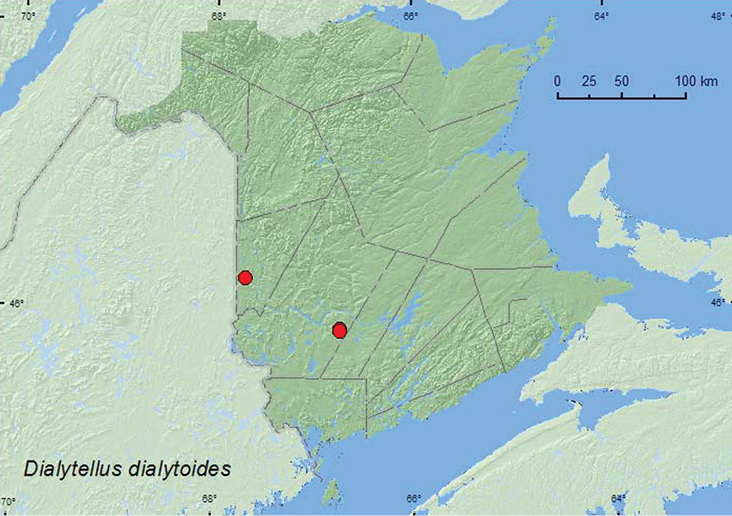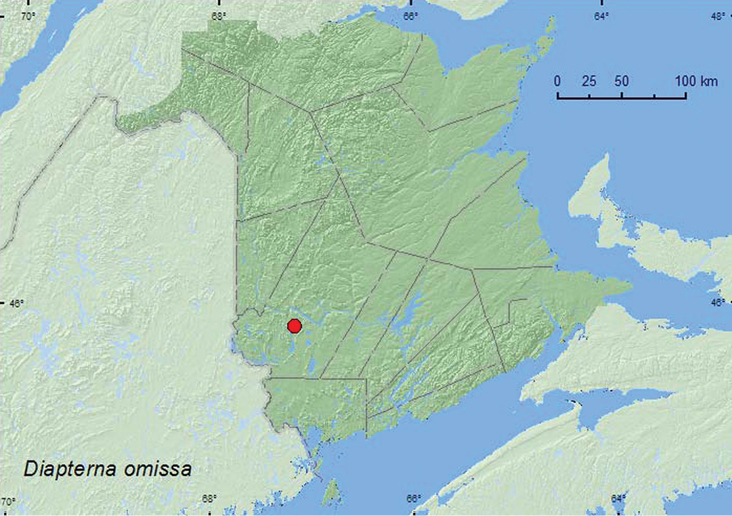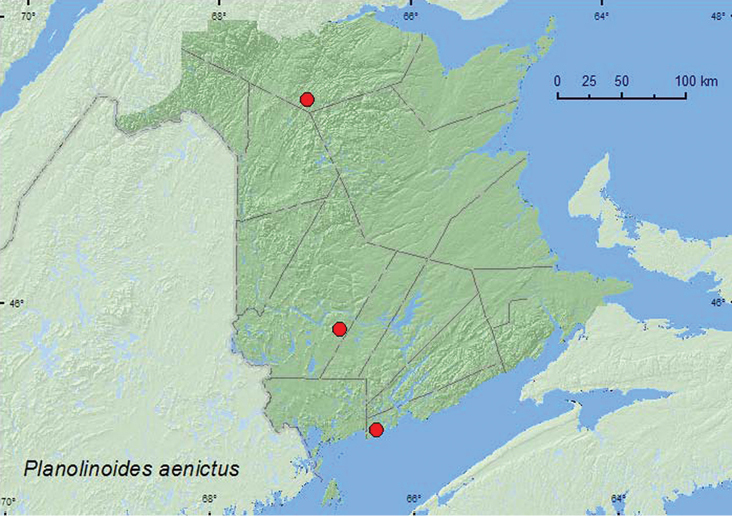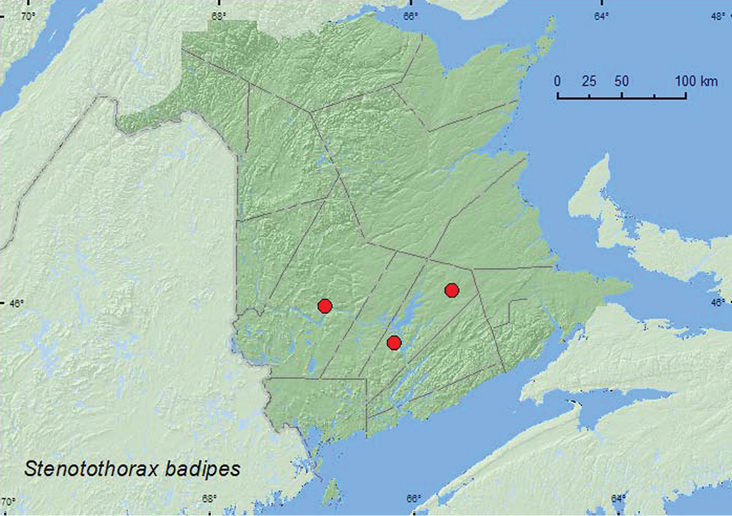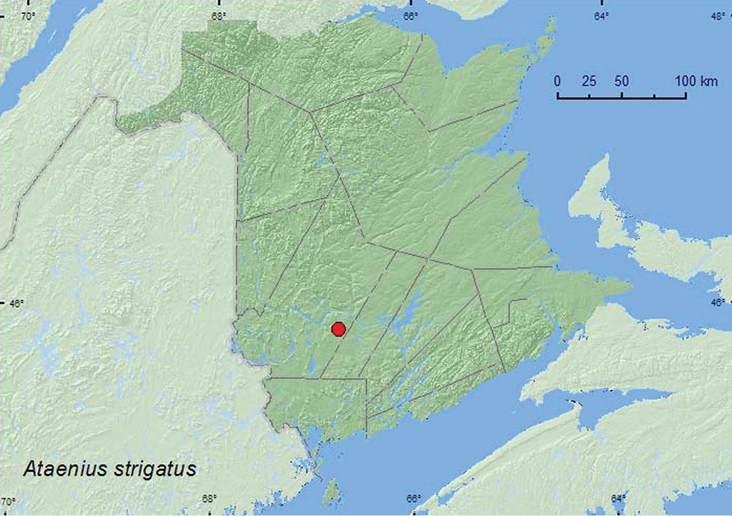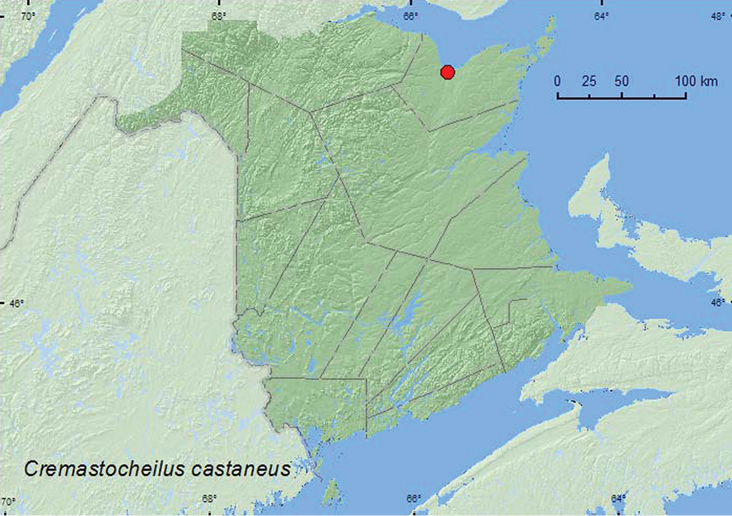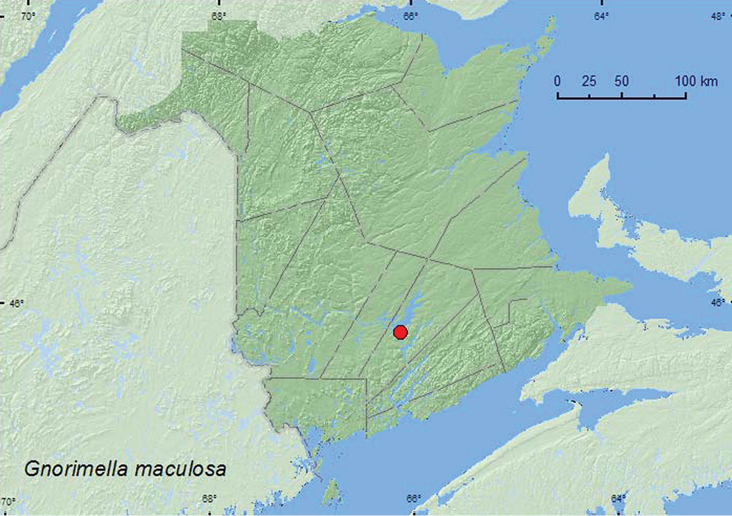






(C) 2012 Reginald P. Webster. This is an open access article distributed under the terms of the Creative Commons Attribution License 3.0 (CC-BY), which permits unrestricted use, distribution, and reproduction in any medium, provided the original author and source are credited.
For reference, use of the paginated PDF or printed version of this article is recommended.
Two species of Geotrupidae, Geotrupes splendidus splendidus (Fabricius) and Odonteus liebecki (Wallis), are newly reported for New Brunswick, Canada. Twelve species of Scarabaeidae are added to the faunal list of the province, including Aegialia criddlei Brown, Caelius humeralis (Brown), Dialytellus dialytoides (Fall), Diapterna omissa (LeConte), Diapterna pinguis (Haldeman), Planolinoides aenictus (Cooper and Gordon), Stenotothorax badipes (Melsheimer), and Ataenius strigatus (Say), which are also newly recorded for the Maritime provinces. Collection data, habitat data, and distribution maps are presented for each species.
Geotrupidae, Scarabaeidae, new records, Canada, New Brunswick
This paper treats new species records from New Brunswick, Canada in the Coleoptera families Geotrupidae and Scarabaeidae. The Geotrupidae (earth-boring scarab beetles), as their common name implies, are burrowers in soil and they provision the burrows for their larvae with dung, fungi, humus, or dead leaves, depending on the species (
Twenty-eight species of Geotrupidae are known from North America (
The following records are based on specimens collected during a general survey by the first author to document the Coleoptera fauna of New Brunswick and from by-catch samples obtained during a study to develop a general attractant for the detection of invasive species of Cerambycidae.
Collection methodsVarious methods were employed to collect the species reported in this study. Details are outlined in
Distribution maps, created using ArcMap and ArcGIS, are presented for each species in New Brunswick. Every species is cited with current distribution in Canada and Alaska, using abbreviations for the state, provinces, and territories. New records for New Brunswick are indicated in bold under Distribution in Canada and Alaska. The following abbreviations are used in the text:
| AK | Alaska | MB | Manitoba |
| YT | Yukon Territory | ON | Ontario |
| NT | Northwest Territories | QC | Quebec |
| NU | Nunavut | NB | New Brunswick |
| BC | British Columbia | PE | Prince Edward Island |
| AB | Alberta | NS | Nova Scotia |
| SK | Saskatchewan | NF & LB | Newfoundland and Labrador |
Acronyms of collections examined or where specimens reside referred to in this study are as follows:
AFC Atlantic Forestry Centre, Natural Resources Canada, Canadian Forest Service, Fredericton, New Brunswick, Canada
CNC Canadian National Collection of Insects, Arachnids and Nematodes, Agriculture and Agri-Food Canada, Ottawa, Ontario, Canada
NBM New Brunswick Museum, Saint John, New Brunswick, Canada
RWC Reginald P. Webster Collection, Charters Settlement, New Brunswick, Canada
ResultsHere, we newly report two species of Geotrupidae and 12 species of Scarabaeidae for New Brunswick, Canada. Aegialia criddlei Brown, Ataenius strigatus (Say), Caelius humeralis (Brown), Dialytellus dialytoides (Fall), Diapterna omissa (LeConte), Diapterna pinguis (Haldeman), Planolinoides aenictus (Cooper and Gordon), and Stenotothorax badipes (Melsheimer) are newly recorded for the Maritime provinces (Table 1).
Species of Geotrupidae and Scarabaeidae reported from New Brunswick, Canada.
| Family Geotrupidae Latreille |
| Subfamily Bolboceratinae Mulsant |
| Tribe Bolboceratini Mulsant |
| Odonteus liebecki (Wallis)* |
| Subfamily Geotrupinae Latreille |
| Tribe Geotrupini Latreille |
| Geotrupes balyi Jekel |
| Geotrupes splendidus splendidus (Fabricius)* |
| Geotrupes stercorarius (Linnaeus) |
| Family Scarabaeidae Latreille |
| Subfamily Aegialiinae Laporte |
| Aegialia blanchardi Horn |
| Aegialia criddlei Brown** |
| Aegialia lacustris LeConte |
| Aegialia nana Brown |
| Aegialia opifex Horn* |
| Caelius humeralis (Brown) |
| Caelius rufescens (Horn) |
| Subfamily Aphodiinae Leach |
| Tribe Aphodiini Leach |
| Acrossus rubripennis (Horn) |
| Agoliinus guttatus (Eschscholtz) |
| Agoliinus leopardus (Horn) |
| Agoliinus manitobensis (Brown) |
| Aphodius fimetarius (Linnaeus) |
| Calamosternus granarius (Linnaeus) |
| Chilothorax distinctus (Müller) |
| Colobopterus erraticus (Linnaeus) |
| Dialytellus dialytoides (Fall)* |
| Dialytes striatulus (Say) |
| Diapterna hyperborea (LeConte) |
| Diapterna omissa (LeConte)* |
| Diapterna pinguis (Haldeman)** |
| Eupleurus subterraneus (Linnaeus) |
| Melinopterus prodromus (Brahm) |
| Oscarinus rusicola (Melsheimer) |
| Otophorus haemorrhoidalis (Linnaeus) |
| Planolinellus vittatus (Say) |
| Planolinoides aenictus (Cooper & Gordon)* |
| Planolinoides borealis (Gyllenhal) |
| Planolinus tenellus (Say) |
| Stenotothorax badipes (Melsheimer)* |
| Teuchestes fossor (Linnaeus) |
| Trichonotulus scrofa (Fabricius) |
| Tribe Euparini Schmidt |
| Ataenius abditus (Haldeman) |
| Ataenius strigatus (Say)* |
| Subfamily Scarabaeinae Latreille /td> |
| Tribe Onthophagini Burmeister |
| Onthophagus hecate (Panzer) |
| Onthophagus nuchicornis (Linnaeus) |
| Subfamily Melolonthinae Leach |
| Tribe Diplotaxini Kirby |
| Diplotaxis tristis Kirby |
| Tribe Hopliini Latreille |
| Hoplia trifasciata Say |
| Tribe Dichelonychini Burmeister |
| Dichelonyx albicollis Burmeister |
| Dichelonyx diluta (Fall) |
| Dichelonyx elongatula (Schonherr) |
| Dichelonyx subvittata LeConte |
| Tribe Melolonthini Leach |
| Phyllophaga anxia (LeConte) |
| Phyllophaga drakii (Kirby) |
| Phyllophaga futilis (LeConte) |
| Tribe Sericini Kirby |
| Serica atracapilla (Kirby) |
| Serica georgiana Leng |
| Serica tristis LeConte |
| Subfamily Dynastinae MacLeay |
| Tribe Pentodontini Mulsant |
| Tomarus relictus (Say) |
| Subfamily Cetoniinae Leach |
| Tribe Cremastocheilini Burmeister & Schaum |
| Cremastocheilus castaneus Knoch* |
| Tribe Trichiini Fleming |
| Gnorimella maculosa (Knoch)* |
| Osmoderma scabra (Palisot de Beauvois) |
| Osmoderma eremicola (Knoch)* |
| Trichiotinus assimilis (Kirby) |
All records below are species newly recorded for New Brunswick, Canada. Species followed by ** are newly recorded from the Maritime provinces (New Brunswick, Nova Scotia, Prince Edward Island) of Canada.
The classification of the Geotrupidae and Scarabaeidae follows
Family Geotrupidae Latreille, 1802 Subfamily Bolboceratinae Mulsant, 1842 Tribe Bolboceratini Mulsant, 1842
New Brunswick, York Co., Charters Settlement, 45.8395°N, 66.7391°W, 10.VI.2007, 25.VI.2009, R. P. Webster, mixed forest, u.v. light (2, RWC).
Both individuals of this species were collected during June at an ultraviolet light deployed near a mixed forest.
http://species-id.net/wiki/Geotrupes_splendidus_splendidus
Map 2New Brunswick, Queens Co., Cranberry Lake P.N.A. (Protected Natural Area), 46.1125°N, 65.6075°W, 11-18.VI.2009, R. Webster & M.-A. Giguère, old red oak forest, Lindgren funnel trap (1, RWC). York Co., Charters Settlement, 45.8428°N, 66.7279°W, 16.IX.2004, 23.IX.2009, R. P. Webster, regenerating mixed forest, baited with pile of decaying mushrooms (2, RWC); Charters Settlement, 45.8395°N, 66.7391°W, 9.IX.2007, R. P. Webster, mixed forest, in decaying (mouldy) corncobs and cornhusks (1, RWC); Canterbury, near Browns Mountain Fen, 45.8964°N, 67.6273°W, 8.IX.2007, R. P. Webster, in flight along woodland trail (1, RWC).
Adultshave been reported from fungi, dung, and various decaying organic material (
New Brunswick, Albert Co., Waterside, Waterside Beach, 45.6282°N, 64.8129°W, 29.V.2010, R. P. Webster & M.-A. Giguère, sea beach, white sand, under log (6, RWC).
No habitat data were reported by
New Brunswick, Queens Co., Bayard, at Nerepis River, 45.4473°N, 66.3318°W, 24.V.2009, R. P. Webster, river margin on sand bar, under log set in sand (1, RWC).
Collection localities in New Brunswick, Canada of Aegialia opifex.
No habitat data on this species were included in
ON, QC, NB, NS, PE (
New Brunswick, Carleton Co., Jackson Falls, Bell Forest, 46.2200°N, 67.7231°W, 12–19.VI.2008, 19–27.VI.2008, R. P. Webster, mature hardwood forest, Lindgren funnel traps (2, RWC); same locality but 46.2150°N, 67.7190°W, 2.VI.2005, M.-A. Giguère & R. Webster, floodplain forest with butternut, adult collected while in flight (1, RWC). Restigouche Co., Dionne Brook P.N.A., 47.9064°N, 68.3441°W, 31.V–15.VI.2011, M. Roy & V. Webster, old-growth white spruce and balsam fir forest, Lindgren funnel trap (1, RWC).
No habitat information was included for this species in
New Brunswick, Carleton Co., Meduxnekeag Valley Nature Preserve, 46.1940°N, 67.6801°W, 12.VIII.2004, 31.VIII.2006, R. P. Webster, hardwood forest, in decaying mushrooms (2, RWC). York Co., Charters Settlement, 45.8428°N, 66.7275°W, 6.X.2005, R. P. Webster, regenerating mixed forest, baited with pile of decaying mushrooms (1, RWC); same locality and collector but 45.8286°N, 66.7365°W, 15.VIII.2004, regenerating mixed forest, baited with pile of decaying mushrooms (3, RWC).
Dialytellus dialytoides is usually associated with deer (Odocoileus virginianus (Zimmerman)) dung in forests or in damp soil under deer dung, although two large series were taken from rotting mushrooms in Quebec and Ontario (
New Brunswick, York Co., Slagundy Dry Ponds, 45.8596°N, 67.1849°W, 8.VII.2006, R. P. Webster, large vernal pond, in moist leaves on pond margin (1, RWC).
New Brunswick, Queens Co., Cranberry Lake P.N.A, 46.1125°N, 65.6075°W, 29.VI-7.VII.2011, M. Roy & V. Webster, old red oak forest, Lindgren funnel trap (1, RWC).
Diapterna pinguis is apparently a detritivore, having been collected in pitfall traps in areas without mammal dung (
http://species-id.net/wiki/Planolinoides_aenictus
Map 9New Brunswick, Restigouche Co., Little Tobique River near Red Brook, 47.4462°N, 67.0689°W, 24.V.2007, R. P. Webster, old growth eastern white cedar swamp, in moss and leaf litter near brook (1, RWC). Saint John Co., Chance Harbour off Rt. 790, 45.1355°N, 66.3673°W, 15.V.2006, R. P. Webster, eastern white cedar swamp, in moss and leaf litter near brook (1, RWC). York Co., New Maryland, Charters Settlement, 45.8430°N, 66.7275°W, 5.V.2006, R. P. Webster, mixed forest, entrance to porcupine den, in porcupine dung (1, RWC).
This species was reported from moose (Alces alces (L.)) dung and carnivore scats in a spruce and sphagnum bog in Ontario as well as from localities in Quebec (
New Brunswick, Queens Co., ca. 3.5 km W of Lower Gagetown, 45.7500°N, 66.1833°W, 17.VI.2009, S. Makepeace & R. Webster, in nest contents of barred owl, relatively dry humus-like soil with oak leaves, no urine smell (4, RWC); Cranberry Lake P.N.A, 46.1125°N, 65.6075°W, 24.IV–5.V.2009, R. Webster & M.-A. Giguère, old red oak forest, Lindgren funnel trap (1, AFC). York Co., Keswick Ridge, 46.0040°N, 66.8776°W, 23.V.2006, S. Makepeace, barred owl nest box with 440 gm chicks, in moist nest material with insect parts and small bones (urine smell) (1, RWC).
Stenotothorax badipes is usually found in nests of such squirrels as the southern flying squirrel (Glaucomys volans (Linnaeus)), the gray squirrel (Sciurus carolinensis Gremlin), and the fox squirrel (Sciurus niger (Linnaeus)), nesting in tree holes filled with pieces of acorns, detritus, and likely squirrel scat (
New Brunswick, York Co., Charters Settlement, 45.8395°N, 66.7391°W, 10.VI.2007, R. P. Webster, mixed forest, u.v. light (1, RWC).
Nothing has been published on the habitat requirements of this species. The only specimen from New Brunswick was collected at an ultraviolet light during June near a mixed forest.
New Brunswick, Gloucester Co., Bathurst, Daly Point Reserve, 16.V.1994, 28.VII.1998, R. P. Webster, old field, pitfall traps (2, RWC).
Two individuals were collected in pitfall traps in an old field with sandy soil. Adults were collected during May and July.
New Brunswick, Queens Co., Grand Lake Meadows P.N.A., 45.8227°N, 66.1209°W, 31.V-15.VI.2010, 15–29.VI.2010, R. Webster & C. MacKay., old silver maple forest with green ash and seasonally flooded marsh, Lindgren funnel traps (10, AFC, RWC); same locality data and forest type, 3–21.VI.2011, 21.VI–5.VII.2011, 5–19.VII.2011, R. Roy & V. Webster, Lindgren funnel traps (20, AFC, NBM, RWC).
Adults of Gnorimella maculosa are often found nectaring on flowers and frequent forested areas (See
ON, QC, NB, NS (
Collection localities in New Brunswick, Canada of Gnorimella maculosa.
New Brunswick, Queens Co., Central Hampstead, 45.6575°N, 66.1412°W, 13.VII.2006, S. Makepeace & R. Webster, hardwood ridge, in nest of barred owl in tree hole (1, RWC); Central Hampstead, 13.VIII.2007, S. Makepeace, near house (1, RWC); Grand Lake Meadows P.N.A., 45.8227°N, 66.1209°W, 29.VI–12.VII.2010, R. Webster, C. MacKay, M. Laity, & R. Johns, old silver maple forest with green ash and seasonally flooded marsh, Lindgren funnel trap (1, AFC); same locality data and forest type, 19.VII–5.VIII.2011, 5-17.VIII.2011, 17–30.VIII.2011, M. Roy & V. Webster, Lindgren funnel traps in forest canopy (14, AFC, NBM, RWC). York Co., Skiff Lake, 15.VIII.1962 (1, AFC); Fredericton, Smythe St. extension, 5.VIII.1945, F. G. Cuming (1 AFC); Fredericton, 8.VIII.1973, 2.VIII.1977 (2, AFC); Douglas, 24.VII.1975 (1, AFC); Charters Settlement, 45.8395°N, 66.7391°W, 30.VII.1993, 13.VIII.2004, R. P. Webster (on ground near house) (2, NBM, RWC).
Larvae of Osmoderma species live in decaying wood in the heart of trunks and branches of old and often declining hardwood trees (
We thank Caroline Simpson (AFC) for editing this manuscript. Serge Laplante (Agriculture and Agri-Food Canada (CNC), Ottawa) is thanked for determining specimens and other assistance. Two anonymous reviewers provided useful comments that improved this manuscript. Nichole Brawn, Katie Burgess, Marie-Andrée Giguère, Jim Edsall, Nancy Harn, Cory Hughes, Rob Johns, Marsell Laity, Colin MacKay, Wayne MacKay, Scott Makepeace, Jessica Price, Michelle Roy, and Vincent Webster are thanked for technical assistance and collecting specimens. Natural Resources Canada Canadian Forest Service; the Canadian Food Inspection Agency; and the USDA APHIS funded the study on early detection of invasive cerambycids, which provided the records from specimens captured in Lindgren funnel traps. The New Brunswick Environmental Trust Fund and New Brunswick Wildlife Trust Fund are thanked for funding various insect surveys over the past 7 years, and the Meduxnekeag River Association is thanked for permission to sample beetles at the Meduxnekeag Valley Nature Preserve (which includes the Bell Forest). The New Brunswick Department of Natural Resources (Fish and Wildlife Branch) is thanked for issuing permits for sampling in the Protected Natural Areas and for providing logistical support.
